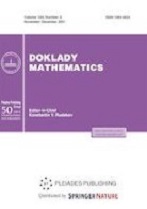|
SPECIAL ISSUE: ARTIFICIAL INTELLIGENCE AND MACHINE LEARNING TECHNOLOGIES
Machine learning as a tool to accelerate the search for new materials for metal-ion batteries
V. T. Osipova, M. I. Gongolabc, E. A. Morkhovaa, A. P. Nemudryib, A. A. Kabanovab
a Samara State Technical University, Samara, Russia
b Institute of Solid State Chemistry and Mechanochemistry of the Siberian Branch of the RAS, Novosibirsk, Russia
c Novosibirsk State University, Novosibirsk, Russia
Abstract:
The search for new solid ionic conductors is an important topic of material science that requires significant resources, but can be accelerated using machine learning (ML) techniques. In this work, ML methods were applied to predict the migration energy of working ions. The training set is based on data on 225 lithium ion migration channels in 23 ion conductors. The descriptors were the parameters of free space in the crystal obtained by the Voronoi partitioning method. The accuracy of migration energy prediction was evaluated by comparison with the data obtained by the density functional theory method. Two methods of ML were applied in the work: support vector regression and ordinal regression. It is shown that the parameters of free space in a crystal correlate with the migration energy, while the best results are obtained by ordinal regression. The developed ML models can be used as an additional filter in the analysis of ionic conductivity in solids.
Keywords:
ionic conductors, voronoi partitioning, topospro, machine learning, migration energy, DFT calculations.
Citation:
V. T. Osipov, M. I. Gongola, E. A. Morkhova, A. P. Nemudryi, A. A. Kabanov, “Machine learning as a tool to accelerate the search for new materials for metal-ion batteries”, Dokl. RAN. Math. Inf. Proc. Upr., 514:2 (2023), 355–363; Dokl. Math., 108:suppl. 2 (2023), S476–S483
Linking options:
https://www.mathnet.ru/eng/danma479 https://www.mathnet.ru/eng/danma/v514/i2/p355
|


|





 Contact us:
Contact us: Terms of Use
Terms of Use
 Registration to the website
Registration to the website Logotypes
Logotypes








 Citation in format
Citation in format 